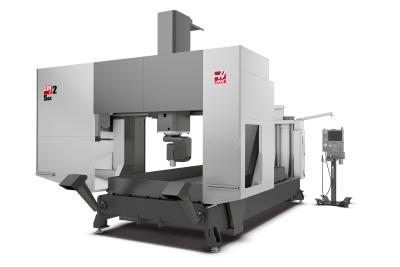
Many industries today, such as aerospace and automotive design, are turning to 5-axis machining to speed manufacturing processes and increase accuracy. The ability to machine complex shapes, undercuts, and difficult angles in a single setup reduces tooling costs and labor time, resulting in a better cost per part.
The Haas GM-2-5AX is a 5-axis gantry mill designed for complex, large-part machining, such as airframe components, layup molds and composite structures. The machine’s dual-axis spindle head provides ±245 degrees of C-axis rotation and ±120 degrees of B-axis tilt for complex surfacing, or to access nearly any angle on a part. Travels are 145" x 87.5" x 39.4" (3683 x 2223 x 1000 mm), with 75" (1905 mm) between columns, and the machine comes standard with a 144" x 72" (3658 x 1829 mm) aluminum table. The GM-2-5AX’s 20,000-rpm HSK 63F spindle features a 13.4 hp (10 kW) integral spindle/motor drive, and a 30+1 tool side-mount toolchanger is standard.
To simplify 5-axis setups, the GM-2-5AX comes equipped with Haas Automation’s powerful Dynamic Work Offsets and Tool Center Point Control software. High-productivity options include the Haas Wireless Intuitive Probing System, a complete coolant system and dual chip augers.
For shops not requiring the flexibility of a dual-axis spindle head, Haas offers a 3-axis version of the GM-2. The 3-axis GM-2 provides the same X and Y axis travels as the 5AX, but with 22" (559 mm) of Z-axis travel, providing more rigidity for heavy machining. The GM-2 features a robust 40-taper inline direct-drive spindle that spins to 8100-rpm, and is powered by a 30 hp (22.4 kW) vector drive system. Optional 10,000-rpm and 15,000-rpm spindles are available for higher surface feeds and small tools. A 30+1 side-mount toolchanger also is standard.
The GM-2 is available with a wide selection options to boost productivity even further, such as high-pressure through-spindle coolant, dual-chip augers, the Haas Wireless Intuitive Probing System and a programmable coolant nozzle.
Contact Details
Related Glossary Terms
- coolant
coolant
Fluid that reduces temperature buildup at the tool/workpiece interface during machining. Normally takes the form of a liquid such as soluble or chemical mixtures (semisynthetic, synthetic) but can be pressurized air or other gas. Because of water’s ability to absorb great quantities of heat, it is widely used as a coolant and vehicle for various cutting compounds, with the water-to-compound ratio varying with the machining task. See cutting fluid; semisynthetic cutting fluid; soluble-oil cutting fluid; synthetic cutting fluid.
- milling machine ( mill)
milling machine ( mill)
Runs endmills and arbor-mounted milling cutters. Features include a head with a spindle that drives the cutters; a column, knee and table that provide motion in the three Cartesian axes; and a base that supports the components and houses the cutting-fluid pump and reservoir. The work is mounted on the table and fed into the rotating cutter or endmill to accomplish the milling steps; vertical milling machines also feed endmills into the work by means of a spindle-mounted quill. Models range from small manual machines to big bed-type and duplex mills. All take one of three basic forms: vertical, horizontal or convertible horizontal/vertical. Vertical machines may be knee-type (the table is mounted on a knee that can be elevated) or bed-type (the table is securely supported and only moves horizontally). In general, horizontal machines are bigger and more powerful, while vertical machines are lighter but more versatile and easier to set up and operate.
- toolchanger
toolchanger
Carriage or drum attached to a machining center that holds tools until needed; when a tool is needed, the toolchanger inserts the tool into the machine spindle. See automatic toolchanger.
- turning
turning
Workpiece is held in a chuck, mounted on a face plate or secured between centers and rotated while a cutting tool, normally a single-point tool, is fed into it along its periphery or across its end or face. Takes the form of straight turning (cutting along the periphery of the workpiece); taper turning (creating a taper); step turning (turning different-size diameters on the same work); chamfering (beveling an edge or shoulder); facing (cutting on an end); turning threads (usually external but can be internal); roughing (high-volume metal removal); and finishing (final light cuts). Performed on lathes, turning centers, chucking machines, automatic screw machines and similar machines.
